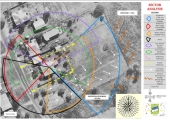




Marco Banks wrote:Any farmer that buys into this "treatment" solution to the millions of gallons of pig shit that their factory farm produces should be required to draw their water down-stream from their operation. How many more of these lagoons need to rupture and pollute everything downstream before there is legislation against them? Make then bath in the creeks down from their toxic pig wasteland.
If an environmentally sane solution causes the cost of pork to rise by a couple of bucks a pound, so be it.
The solution is to not overstock the land with more animals than can reasonably poop their waste on the ground to be naturally fed into the soil. Confined feeding operations are cruel, plain and simple. Pigs were created to wander the forest and eat acorns. As Joel Salatin puts it, "Let the pig express his pig-ness." There certainly are plenty of forested plots in North Carolina that could be thinned and turned into free-range paddocks. That would provide lumber for the North Carolina furniture industry (which is quiet large), grazing habitat for the hogs, and completely eliminate the need for storage lagoons for a bazillion gallons of concentrated toxic pig shit.
This is Joel's pastured pig operation.
https://www.youtube.com/watch?v=who0VEOPvkk
https://www.youtube.com/watch?v=JjBtZxlkEDw
His phrase is "a light footprint" --- no concrete, no fans, no electricity, no smell, and certainly no pig shit lagoons.
Tyler Ludens wrote:Here are a couple links I found which might help:
https://today.tamu.edu/2017/01/26/closed-loop-concept-could-be-the-future-of-sustainable-animal-farms/
https://link.springer.com/article/10.1007/s40093-014-0050-6
wayne fajkus wrote:I saw one impressive system. It wasnt the raising side, but the slaughter side. All byproducts were ground and fed into a massive worm farm.